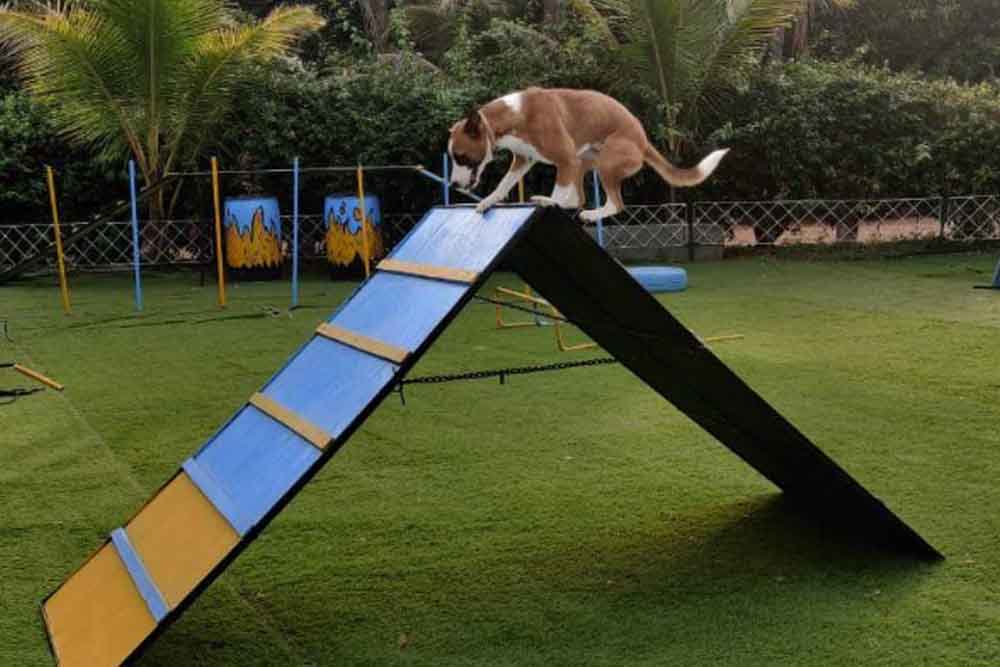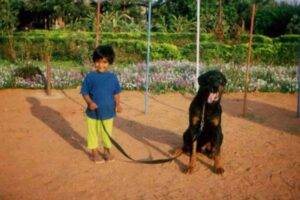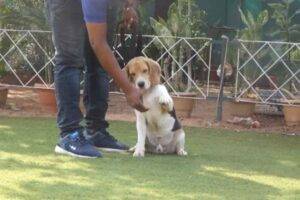Introduction:
Training dogs is an enriching journey that extends beyond breed boundaries. Let’s explore effective training techniques for Indian dog breeds ( which are applicable to other breeds as wee!), emphasizing their unique qualities and training achievements. Drawing from personal success stories and expert knowledge, we will delve into the science of training, offering insights into unlocking the potential of these remarkable canine companions.
Indian dog breeds encompass a diverse range of traits and temperaments, requiring a tailored approach to training. These breeds have a rich history and cultural significance in the Indian subcontinent. Let’s explore some of the most well-known Indian breeds and their distinct characteristics:
1. Indian Pariah Dog:
The Indian Pariah Dog, also known as the Desi Dog, is an indigenous breed found throughout India. They possess exceptional adaptability, intelligence, and agility. Historically, they served as versatile working dogs and loyal companions. Due to their intelligence and versatility, they excel in various training activities such as obedience, agility, and even scent work.
2. Rajapalayam:
Originating from Tamil Nadu, the Rajapalayam is a powerful and majestic breed known for its loyalty, fearlessness, and guarding instincts. Their strong physique and endurance make them excellent hunting and guarding dogs. Training Rajapalayams requires a firm but gentle approach, utilizing positive reinforcement methods to channel their protective instincts and energy effectively.
3. Mudhol Hound:
Hailing from the region of Karnataka, the Mudhol Hound is a sighthound renowned for its incredible speed, agility, and endurance. They have a strong prey drive and were traditionally used for hunting small game. Training Mudhol Hounds involves incorporating activities that engage their natural instincts, such as lure coursing or obedience training that emphasizes their speed and agility.
4. Indian Mastiff (Bully Kutta):
The Indian Mastiff, commonly referred to as the Bully Kutta is a large and powerful breed known for its protective instincts and loyalty. They have been traditionally utilized as guard dogs and for livestock protection. Due to their size and protective nature, early socialization and consistent training are crucial to ensure they develop appropriate behaviour and manners.
5. Gaddi Kutta:
The Gaddi Kutta is a rugged mountain dog found in the Himalayan region. They are highly adaptable to harsh terrains and extreme weather conditions. Their primary role has been that of a livestock guardian, protecting herds from predators. Training Gaddi Kuttas involves harnessing their natural guarding instincts while also teaching them to differentiate between potential threats and friendly visitors.
Understanding the distinct qualities and purposes of these Indian breeds lays the foundation for effective training methods tailored to their specific needs. By recognizing their inherent strengths and traits, trainers can develop training programs that cater to their physical abilities, intelligence, and instincts.
Core Training Principles
While Indian breeds have their unique traits, there are fundamental training principles that apply universally to all breeds. These principles establish a solid foundation for effective training and ensure a positive and successful experience for both the trainer and the dog.
1. Positive Reinforcement:
Positive reinforcement is a powerful training technique that focuses on rewarding desired behaviours rather than punishing unwanted behaviours. By using rewards such as treats, praise, and play, trainers can motivate and encourage dogs to repeat those behaviours. This method strengthens the bond between the trainer and the dog, fosters a positive learning environment, and promotes the dog’s willingness to cooperate. Indian breeds, known for their intelligence and eagerness to please, respond particularly well to positive reinforcement training.
2. Consistency and Repetition:
Consistency is key in dog training. Dogs thrive in an environment where they can predict and understand the expectations placed upon them. By using consistent cues, commands, and routines, trainers can effectively communicate with their dogs and help them understand what is expected of them. Additionally, repetition is essential for learning. Dogs need ample practice to master new skills and behaviours. Patiently repeating training exercises and gradually increasing difficulty ensures that the dog comprehends and retains what is being taught.
3. Patience and Persistence:
Training takes time, and every dog learns at its own pace. Patience is a virtue in dog training, as it allows trainers to remain calm and understanding during the learning process. Some dogs may pick up new behaviours quickly, while others may require more time and repetition. It is crucial to be patient, avoid frustration, and celebrate small victories along the way. Persistence is equally important. Consistent training sessions, even in the face of challenges, will ultimately yield results. Through consistent and persistent training efforts, dogs can develop the desired behaviours and skills.
4. Socialization:
Socialization plays a vital role in the development of well-rounded dogs. Exposing dogs to various environments, people, animals, and stimuli from an early age helps them become confident and adaptable. It reduces the likelihood of fear, aggression, and anxiety in unfamiliar situations. For Indian breeds, which are often used as guard dogs or in specific roles, socialization is particularly important to ensure they can differentiate between real threats and harmless situations. Organized puppy classes, supervised interactions, and controlled exposures are effective ways to socialize dogs and help them become comfortable and well-behaved members of society.
5. Clear Communication:
Effective communication between the trainer and the dog is essential for successful training. Dogs primarily rely on body language, tone of voice, and consistent cues to understand what is expected of them. Clear communication involves using concise and distinct commands, maintaining a confident yet calm demeanor, and being aware of one’s own body language. Clarity in communication helps dogs understand what is desired from them, resulting in quicker and more accurate responses.
By applying these core training principles of positive reinforcement, consistency and repetition, patience and persistence, socialization, and clear communication, trainers can effectively train Indian breeds and any other breed. These principles form the building blocks for a strong foundation in training and create a positive learning environment for dogs. In the next section, I will share personal success stories from my experience in training Indian breed dogs, highlighting their achievements and the effectiveness of these core training principles.
Through my personal success stories, I have witnessed the incredible transformations that Indian breed dogs can undergo with the right training approach.
In my experience as part of the training team at Commando Kennels, I have had the privilege of working with Indian breed dogs and witnessing their remarkable progress through effective training methods. Here, I will share some personal success stories that highlight the achievements of Indian breed dogs and demonstrate the effectiveness of the core training principles discussed earlier.
1. Shiny, the Indian Pariah Dog:
Shiny, a young Indian Pariah Dog, came to me with fear and anxiety issues. Through patient socialization and positive reinforcement training, Shiny gradually gained confidence and overcame her fears. We started with basic obedience training, using treats and praise to reward her for following commands. As Shiny’s confidence grew, we introduced her to new environments, people, and dogs, carefully monitoring her reactions and providing reassurance. Over time, Shiny blossomed into a well-adjusted and social dog, showcasing her intelligence and eagerness to learn. She went on to excel in agility training, displaying impressive speed, agility, and problem-solving skills.
2. Raja, the Rajapalayam:
Raja, a Rajapalayam, had a history of aggression issues due to improper socialization. With consistent training and positive reinforcement techniques, we focused on redirecting his guarding instincts into positive behaviours. Raja responded well to clicker training, a form of positive reinforcement that uses a distinct sound to mark desired behaviours, followed by treats or rewards. Through careful management, controlled interactions, and gradual exposure to new situations, Raja learned to trust and respond positively to commands. Today, Raja is a well-mannered and obedient dog, demonstrating the remarkable transformation that can be achieved with the right training approach.
3. Rocky, the Mudhol Hound:
Kali, a spirited Mudhol Hound, possessed an abundance of energy and a strong prey drive. To channel his energy and instincts, we incorporated lure coursing into his training routine. Lure coursing is a sport that simulates chasing prey using a mechanized lure. By engaging Rocky in this activity, we provided him with an outlet for his natural instincts and utilized positive reinforcement to reward his focus and speed during training sessions. Rocky quickly became a skilled and enthusiastic lure courser, showcasing his incredible speed, agility, and determination.
4. Simba, the Gaddi Kutta:
Simba, a Gaddi Kutta from the Himalayan region, had a strong guarding instinct and was often overprotective of his family. We implemented controlled socialization and obedience training to address his protective tendencies while fostering a balanced and well-behaved dog. By exposing Simba to various situations, teaching him to differentiate between friend and foe, and providing consistent training and positive reinforcement, Simba learned to discern when guarding behaviour was appropriate. He became a trusted and reliable family guardian, excelling in his role while remaining friendly and sociable in everyday interactions.
These personal success stories demonstrate the remarkable potential of Indian breed dogs and the effectiveness of positive training methods. By employing the core training principles of positive reinforcement, consistency, patience, socialization, and clear communication, trainers can bring out the best in these breeds and create harmonious relationships with their dogs.
Training Indian breed dogs and any other breed is a rewarding and fulfilling journey that requires an understanding of their unique qualities, a commitment to core training principles, and a tailored approach to their specific needs. Each breeds brings their own set of characteristics and historical roles to the training process.
By recognizing the strengths and traits of Indian breeds, trainers can develop training programs that capitalize on their intelligence, agility, loyalty, and protective instincts. Implementing positive reinforcement techniques, such as rewards and praise, establishes a strong bond between trainers and dogs and motivates them to excel in their training. Consistency, repetition, patience, and persistence are key to instilling desired behaviours and skills in dogs of all breeds.
Socialization plays a vital role in shaping well-rounded Indian breed dogs. Exposing them to different environments, people, and stimuli from an early age helps them become confident and adaptable. Clear communication, both verbal and non-verbal, enables effective understanding between trainers and dogs, facilitating the learning process.
In training Indian breed dogs, it is essential to celebrate their achievements and appreciate their unique contributions to the canine world. By employing positive training methods, consistency, patience, socialization, and clear communication, trainers can unlock the full potential of these breeds and develop strong bonds that result in harmonious coexistence between humans and dogs.
Ultimately, the training journey is about creating well-behaved, happy, and fulfilled dogs that bring joy to our lives. By understanding and embracing the individual qualities of Indian breeds and other breeds alike, we can ensure their well-being, enhance their skills and behaviours, and foster a deep and lasting connection between humans and dogs.




